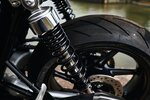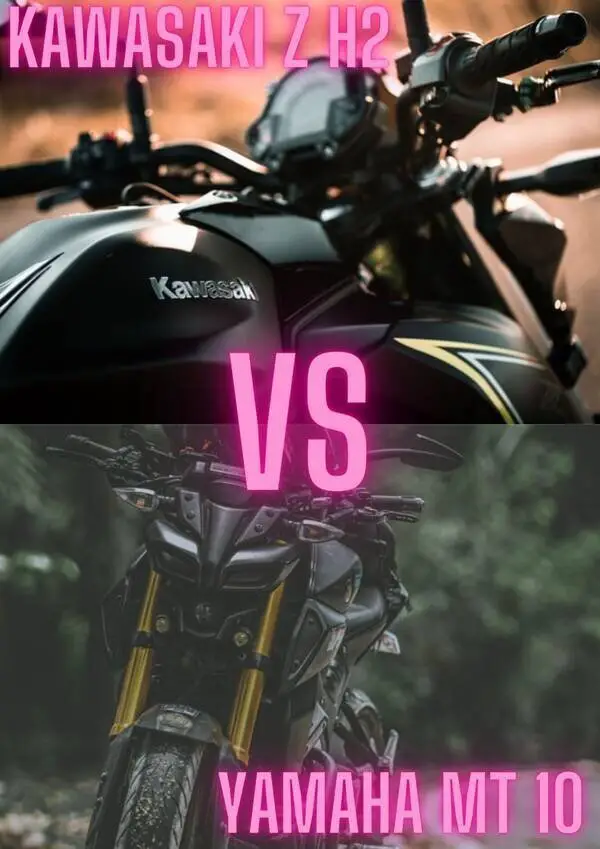This is the ultimate comparison of Kawasaki Z H2 Vs. Yamaha MT 10, and here we will see which one of these roadsters has what to offer to their riders.
Naked bikes or roadsters have shown tremendous growth and innovation in recent times because of high demand. More and more people are looking to buy them because they are very versatile. You can run errands on them or can use them for commuting. They pack enough power to give you some thrill rides as well.
That’s why manufacturers are equipping them with even more engine power to lead the competitions. Two of such bikes are Kawasaki Z H2 and Yamaha MT 10. Both these bikes are pretty fast, and they are equally versatile as well.
In this comparison, we’ll talk about Kawasaki Z H2 Vs. Yamaha MT 10 to conclude which one of them comes out on top.
So keep reading!
Industry History
Kawasaki
Kawasaki is one of the top motorcycle manufacturers globally and has produced some quality bikes right from its inception. It was one of the first international brands in the US and is well-known for equipping its bikes with powerful engines that deliver exceptional performance.
Yamaha
Yamaha has revamped itself and has become one of the top producers of motorcycles in the world. It is well known for providing consumers with multiple finish options, and in terms of looks, this is arguably the best motorcycle brand on the market. Apart from that, Yamaha also makes prolific engines for exceptional road performance.
Kawasaki Z H2 Vs. Yamaha MT 10 – An Overview
The Z H2
Kawasaki’s Z H2 petrol roadster is a powerhouse with a 4-cylinder 998cc engine and a DOHC double camshaft. It is a liquid-cooled engine, and you won’t have to deal with any engine overheating issues at high speeds. It can deliver high-speed performance, and you can ride it for a longer distance as it houses a 19L fuel tank.
The MT 10
Yamaha’s MT 10 is also a petrol roadster, and it is made of durable cast aluminum to make the ride lightweight. Therefore, maneuvering becomes much easier here. It also features 998cc displacement, and due to its lightweight, it can gain quicker acceleration. Yamaha has equipped it with a 17L fuel tank, so you can conveniently use it to ride longer distances.
Comparison Chart
| Features | Kawasaki Z H2 | Yamaha MT 10 |
| Fuel and vehicle type | Petrol roadster | Petrol roadster |
| Fuel tank capacity | 19L | 17L |
| Displacement | 998cc | 998cc |
| Maximum power | 200 HP @ 11,000 RPM | 160 HP @ 11,500 RPM |
| Maximum torque | 137 Nm @ 8500 RPM | 111 Nm @ 9,000 RPM |
| Seating capacity | 2 | 2 |
| Seating type | Dual stepped | Dual stepped |
| Weight | 527 lbs | 463 lbs |
| Gear transmission | 6-gear sequential hydraulic chain drive | 6-gear sequential hydraulic chain drive |
| Front and rear suspension | The hydraulic telescopic fork and progressive mono-shock | Inverted hydraulic fork and progressive mono-shock |
| Front and rear wheel size | 120/70-ZR17 and 190/55-ZR17 radial tubeless | 120/70 ZR17MC and 190/55 ZR17MC radial tubeless |
| Wheelbase | 57.28 inches | 55.12 inches |
| Brakes | Dual (semi-floating) disc and disc | Dual disc and DSC |
Engine
Let’s discuss the engine first in this comparison of Kawasaki Z H2 Vs. Yamaha MT 10. Both these machines feature 998cc displacement, so the engine performance will be a lot more similar.
However, in terms of acceleration, Yamaha will perform much better because it has lightweight, so the engine will respond much quicker.
In addition to that, maneuvering will be much better on this bike as compared to Z H2. Both the bikes come with inline 4-cylinder engines, and they perform pretty well, ensuring excellent acceleration when you need it. As the engine types are the same, performance is slightly better for MT 10 there for Yamaha is ahead in this round.
Weight
Weight is an integral factor in this comparison of Kawasaki Z H2 Vs. Yamaha MT 10. Both these bikes come with a similar type of engine. And the ride with the lightweight will perform much better. It will also be easier to handle and accelerate under the same conditions.
A bike with a lightweight design becomes much easier to handle for lean riders. It can also respond much more quickly to any twist of throttles because there is less drag on the road, and there is lesser resulting wind resistance. This is precisely why lightweight bikes are more responsive and are easier to handle.
The MT 10 is significantly lighter than the Z H2 and is of quality cast aluminum, much lighter than the steel chassis of Z H2. So, in each gear, you will get more acceleration and speed in the case of MT 10. So, Yamaha takes the lead in this round.
Suspension

Now, let’s talk about the suspension system of Kawasaki Z H2 Vs. Yamaha MT 10. Both come with progressive mono-shock suspension systems on the rear end for an extremely comfortable ride at high speeds.
The front-end suspension system in each bike differs slightly as the Z H2 features an inverted telescopic fork while the MT 10 features an inverted hydraulic fork.
The telescopic fork is better at higher speeds when you are riding on slightly uneven surfaces. On the other hand, the hydraulic fork is much better when you are going at regular speeds.
But based on the overall weight of the machines, both these suspension systems work well respectively. So, there is a tie in terms of overall performance. However, Kawasaki is a bit better in terms of ride experience because it’s a lot smoother. So, this round goes to Z H2 but only by the slightest margin.
Ergonomics
When it comes to the riding experience, the winner of this Kawasaki Z H2 Vs. Yamaha MT 10 round-up is Kawasaki again because it is slightly more ergonomic in design with an easily reachable handlebar and footrests.
Even shorter riders can work with it pretty easily, but maneuvering can be difficult due to the overall weight. This is where the Yamaha MT 10 comes out on top as it is lighter. But riding the Z H2 is much more subtle, thanks to the ergonomic design of this bike.
Electronics
Both these bikes come with powerful engines, and they both can manage displacements of 998cc. Judging by that, it’s safe to say that both these machines don’t need many electric upgrades to produce power.
However, they both come with electric ignition systems that are pretty quick to start. The Yamaha features an electric TCI system, while the Kawasaki features an electric CDI. TCI ignitions perform better with time as the engine heats up properly.
With a CDI system, you can reach peak performance pretty quickly. And this is where Kawasaki nudges ahead of Yamaha in this comparison of Kawasaki Z H2 Vs. Yamaha MT 10.
Looks and aesthetics
For us, it’s pretty much a tie between both these machines because they both look extraordinary. Yamaha is slightly better here because it offers more finishes and colors as compared to other brands. And your ride will look much sportier.
This is not the case with the Kawasaki. It doesn’t come with many finishes, and your options are limited here.
Riding comfort

This factor will be a lot more critical than you think because traditionally, Yamaha and Kawasaki are not well-known for their riding comforts. These bikes are better for shorter rides, and similar is the case with both these machines.
The winner of this round in this comparison of Kawasaki Z H2 Vs. Yamaha MT 10 is the Kawasaki Z H2 but only by a smaller margin. The seating position is upright, but you will have that sportbike kind of seating style in there.
The stepped design of the seat will keep you in place when you are accelerating. It feels a bit stiff on your butt, and you will feel fatigued after riding on it for a while.
You will notice a similar design on the MT 10 as well, but things quickly get worse when you start experiencing that butt plug (or whatever you want to call it) upon your tailbone. It is there to stop the slippage when you are riding at higher speeds.
This plug does get plugged into your tailbone and start hurting in no time. With this plugin place, you cannot ride your MT 10 for longer periods. It gets frustrating when you are enjoying the speeds, and at the same time, your butt starts to hurt like crazy.
Pricing
In terms of pricing, Yamaha MT 10 is ahead of Kawasaki Z H2 because it’s a bit less expensive. There is not much difference in terms of performance. The maneuverability is much better in the case of MT 10 as well.
Plus, you can always go for your favorite color with Yamaha. So, The MT 10 is priced daily compared to the Z H2 and takes the lead here.
But you need to keep in mind that the massive price tags on both these machines are due to the power-packed performance and not the overall riding comfort.
Because both these machines are not comfortable to ride for hours and hours. They are all about just doing your things and take a break!
Additional features
As both these machines are roadsters, you will not find any radios or stereo systems on them. However, both the machines do come with turn signals and rear and front LED lights. The overall design remains pretty smooth and aerodynamic, and both the machines are built for attaining high speeds.
Kawasaki Z H2 Vs. Yamaha MT 10 – The Similarities
Fuel and vehicle types
Both these machines are powered by petrol and are roadsters. They both are much similar to one another in terms of looks. Yamaha is slightly ahead for having more color options.
Engine and performance

In terms of engine and performance, these machines are similar because they come with 998cc displacement. The only difference between the two is that the MT 10 is lighter in weight. Hence, it is much easier to maneuver and accelerate.
Gearing system

These machines come with a 6-gear chain drive system. However, Yamaha is ahead here as well because of its lightweight design as it can accelerate better. Both the machines come with a wet sequential gearbox, and the overall gear transitions are smooth in both these machines.
Seating type and capacity
Both the machines come with a seating capacity for two, and they both come with a dual-stepped design. However, Kawasaki will perform much better when you ride a pillion on your bike because it can handle more load due to its heavy-duty steel construction for a more stable ride.
Kawasaki Z H2 Vs. Yamaha MT 10 – Pros & Cons
Kawasaki Z H2
Pros:
- Supercharged powerful engine.
- Quick shifting gearbox with smooth transitions.
- Looks are fabulous.
- Strongly built.
Cons:
- Fuel economy is on the lower side.
- Not very comfortable for longer rides.
Yamaha MT 10
Pros:
- Extremely fast.
- Fun to ride and excellent responsiveness.
- Different color options are available.
Cons:
- Seating is not very comfortable.
- Cruise control is a bit too sensitive.
Conclusion
In our opinion, the winner of this comparison of Kawasaki Z H2 Vs. Yamaha MT 10 by a close margin is the Kawasaki Z H2 because of its overall performance and ride experience.
The MT 10 is not slow by any stretch of the imagination, but the ride comfort is not there. However, Yamaha should have given a second thought to that discomforting seat design.
None of these machines is built for a comfortable long-ride experience. But still, Kawasaki does that job pretty well with a comparatively better seat.
The butt-plug seat design of the MT 10 will cause a lot of pain on longer rides, especially in your tailbone. So, you need to give it a little thought because you spend on it.


